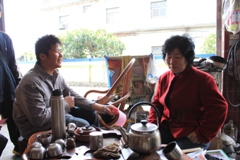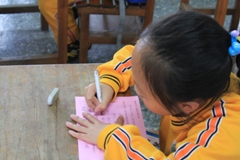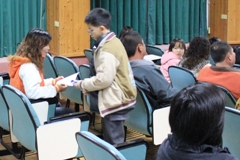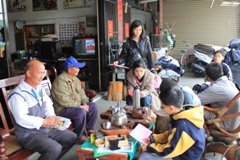We distributed questionnaires to three groups of people, one group consisted of parents of our community who attended the parent-class meeting held at our school, another was the residents of our community whom we interviewed, and the third was the students of our own school. We distributed 150 questionnaires in total, 116 of which were valid responses, out of which 29 came from parents of the community, 18 from residents of the community, and 69 from students. After the responses were calculated and analyzed, we obtained the following date:
Question number |
Question |
Option 1 |
Number of Responses |
Option 2 |
Number of Responses |
1 |
Do you like to watch classical lion dance (traditional lion dance) performances? |
Yes |
83 |
No |
33 |
2 |
Do you like to watch Samba lion dance (modern lion dance) performances? |
Yes |
96 |
No |
20 |
3 |
Would you like to learn classical lion dance (traditional lion dance)? |
Yes |
57 |
No |
59 |
4 |
Would you like to learn Samba lion dance (modern lion dance)? |
Yes |
58 |
No |
58 |
5 |
Would you like to learn how to make classical lion headpieces? |
Yes |
76 |
No |
40 |
6 |
Would you like to learn how to make Samba lion masks? |
Yes |
74 |
No |
42 |
7 |
Do you think a traditional art form like lion dance will eventually die out because of societal changes? |
Yes |
29 |
NO |
87 |
8 |
Do you think lion dance can become a local cultural trait? |
Yes |
96 |
NO |
20 |
We based our analysis on the responses from the above questions:
Question number |
Analysis and Discussion |
Analytical Charts |
1 |
Based on the data we gathered, over two thirds of respondents like to watch traditional lion dance performances, whether it be a temple fair, a celebration, or even elections and mayors’ inaugurations, there are always performances given by lion dance troupes.
Traditional lion dance symbolizes auspiciousness and blessing, therefore it has great cultural significance to the people of the community, and many community members consider watching traditional lion dances at temple fair and celebrations an important part of their daily life. |
|
2 |
We can also see from the data that over four fifths of respondents like to watch modern Samba lion performances. Many community residents saw the Samba lion for the first time and found the performance refreshingly novel, and it is precisely this novelty that provides for us an opportunity to further promote Samba lion dance in the community.
Creativity is for prospering tradition, therefore we would like to suggest that when we at the school design our performances in the future, we may integrate more traditional elements, such as dance routines and martial art moves. |
|
3 |
We can see from the analysis that nearly half of the respondents expressed a wish to learn traditional lion dance. Currently, we train in martial arts every Monday morning and practice lion dance on Tuesdays and Thursdays. Our community also holds traditional lion dance instruction sessions in front of Puhsuan Temple every Friday evening and Saturday afternoon, all of which encourages the members of our community to learn.
We currently have only 18 students in our dance troupe, therefore we would like to suggest that we admit more students as well as those from the lower grades into the school dance troupe. |
|
4 |
We can see from the data gathered that half of the respondents expressed wishes to learn Samba lion dance, and because Samba lion dance is a novelty to most people and more modern, we consider it a feasible idea.
Right now only students from the sixth grade take part in Samba lion dance, therefore we suggest that school allows the establishment of a dance club, recruit students from the 4th, 5th and 6th grades, incorporate more elements from traditional lion dance, innovate different methods of performance, and work with the Community Development Council to further promote the activity. |
|
5 |
We find from the analysis that almost three quarters of the respondents expressed wishes to learn how to make traditional lion headpieces as well as Samba lion masks. In our research project, the members of our team all personally engaged in the production of both traditional lion headpieces and Samba lion masks, moreover, we made footage shot during the production process into webpage content and video for promotional purposes. These efforts successfully aroused the interest of the respondents, thereby proving the effectiveness of our promotion.
Nowadays, countries around globe are all endeavoring to recycle and reuse in an effort to conserve the resources of Mother Earth. We fully support this concept by making our traditional lion headpieces and Samba lion masks entirely out of recycled products and appliances from our daily life.
We plan to suggest that the school incorporate teaching how to make traditional lion headpieces and Samba lion masks into our art class or lifestyle class curriculum so that the entire student body may have the opportunity to learn.
We also plan to contact the Community Development Council and ask them to incorporate teaching how to make traditional lion headpieces and Samba lion masks into their list of community events. |
|
6 |
|
7 |
Based on our data, we find that up to four fifths of our respondents did not feel societal changes would be detrimental to the continuation of traditional lion dance. When we interviewed our lion dance coach, he expressed concern that in a highly commercial society few people have the leisure to learn lion dance, the reason why so few people are engaged in the art.
According to our research, people express high levels of willingness to learn, and we feel that the promotional efforts we tried to incorporate into this research project has indeed paid off; we also hope that our research has contributed to the continuation of traditions within the community. |
|
8 |
Our data also shows that over four fifths of our respondents think that lion dance could become a local cultural trait, and we are happy to hear that this opinion is widely shared at the school and in our community.
Regarding the promotional event for traditional lion dance and Samba lion dance in becoming local cultural traits, we believe our endeavors have been of some contribution, and we further hope that our school may work with the community in encouraging residents to engage in lion dance, and that one day lion dance will indeed become the cultural trait of Sijhou Township. |
|
|


























